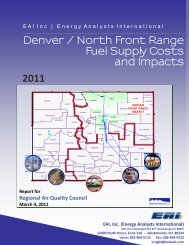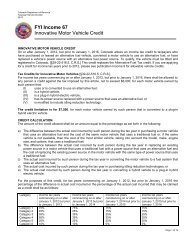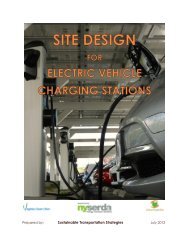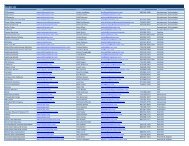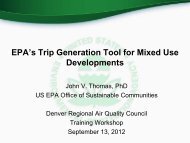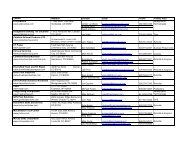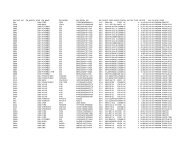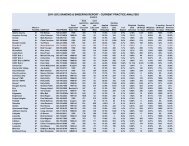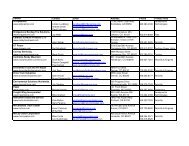Attachment - Regional Air Quality Council
Attachment - Regional Air Quality Council
Attachment - Regional Air Quality Council
Create successful ePaper yourself
Turn your PDF publications into a flip-book with our unique Google optimized e-Paper software.
RAQC MEMBERS PRESENT:<br />
Andy Spielman, Chairman, Hogan Lovells<br />
Melissa Chalona, CTL|Thompson Inc.<br />
Bob Fitzgerald, City of Aurora<br />
Rick Garcia, Department of Urban Housing and Development (advisory)<br />
Darryl Jones, Coventry Development<br />
Elise Jones, Colorado Environmental Coalition<br />
Richard Long, Citizen<br />
Ben Manvel, City of Fort Collins<br />
Paul Natale, City of Commerce City<br />
John Putnam, Kaplan, Kirsch, & Rockwell, LLP<br />
Jep Seman, Corporate Advocates<br />
Nancy Severson, Denver Department of Environmental Health<br />
Nancy Sharpe, City of Greenwood Village<br />
Will Toor, Boulder County<br />
Elena Wilken, Colorado Association of Transit Agencies<br />
RAQC MEMBERS NOT PRESENT:<br />
Debra Baskett, City and County of Broomfield<br />
Reeves Brown, Colorado Department of Local Affairs<br />
Eric Doering, Town of Frederick<br />
Don Hunt, Colorado. Department of Transportation<br />
Linda Morton, Morton Consulting Co<br />
Bob Murphy, City of Lakewood<br />
Jennifer Schaufele, Denver <strong>Regional</strong> <strong>Council</strong> of Governments<br />
Skip Spensley, Environmental Consultant<br />
David Stewart, EnCana Oil & Gas (USA)<br />
Chris Urbina, Colorado Department of Public Health and Environment<br />
RAQC ALTERNATES PRESENT:<br />
Andy Hill, Colorado Department of Local Affairs<br />
Carla Perez, <strong>Regional</strong> Transportation District<br />
Debra Perkins-Smith, Colorado. Department of Transportation<br />
Martha Rudolph, Colorado Department of Public Health and Environment<br />
1<br />
MINUTES<br />
Friday, October 7, 2011<br />
RAQC STAFF PRESENT:<br />
Ken Lloyd, Sarah Anderson, Kate Cooke, Misty Howell, Steve McCannon, Aneka Patel, and Kate Riegle.<br />
OTHERS PRESENT:<br />
Cindy Allen, Encana; Will Allison, APCD; Theresa Amoroso, APCD; Greier Bailey, CWPMA; Kris Bohling,<br />
Wagner Equipment; Andrew Casper, COGA; Josh Epel, PUC; Sherman Feher, Arapahoe County; Karen<br />
Hancock, City of Aurora; Garry Kaufmann, APCD; Mark McMillan, APCD; Melissa Miles, CSSGA; Mim Mirsky,<br />
Denver Environmental Health; Scott Patefield, APCD; Natalia Swalnick, American Lung Association; Jeff<br />
Sudmeier, CDOT; Curt Taipale, APCD; Gregg Thomas, City and County of Denver; Rose Waldman, APCD;<br />
Jerry Williams, DIA; and Bob Yuhnke, SWEEP.<br />
The meeting was called to order at 9:40 a.m. by Chairman Andy Spielman. A quorum was present.
Approval of Agenda<br />
Jep Seman moved to approve the agenda. Seconded by Dick Long. Motion passed without<br />
objection.<br />
Approval of Minutes<br />
Dick Long moved to approve the minutes. Seconded by John Putnam. Motion passed<br />
without objection and with abstentions (Bob Fitzgerald, Nancy Severson and Elise Jones).<br />
Informational Items<br />
Chair<br />
Andy Spielman introduced Will Allison, the new Director of the <strong>Air</strong> Pollution Control Division, to<br />
<strong>Council</strong>.<br />
Executive Director<br />
Ken Lloyd said he sent an email notice to <strong>Council</strong> members indicating that the Governor’s office is<br />
considering new appointments to the RAQC and that members need to submit an application and<br />
resume if they are interested in continuing service on the RAQC board. He noted it is not necessary<br />
for agency members to reapply. Ken also asked that members let him know if they were not<br />
interested in continuing service.<br />
Ken provided <strong>Council</strong> with an overview of the 2010 audited financial statements. He said the<br />
RAQC is in good financial shape. <strong>Council</strong> had no additional questions.<br />
Members<br />
Martha Rudolph said CDPHE is in the process of finalizing its updated strategic plan. She stated<br />
CDPHE has identified 10 goals, three of which related to environmental programs including clean<br />
water, safe food and clean air. The plan will be submitted to the legislature in November. If<br />
<strong>Council</strong> members want additional information contact Martha directly.<br />
Public Comment<br />
None.<br />
Discussion of Next Steps in Implementing EPA’s 2008 (0.075 ppm) Ozone Standard<br />
Ken Lloyd reviewed a memo from Gina McCarthy, EPA Assistant Administrator, regarding<br />
implementation of the 0.075 ppm Ozone National Ambient <strong>Air</strong> <strong>Quality</strong> Standard. The memo<br />
indicated that EPA is moving ahead with certain required actions to implement the 2008 standard<br />
while being mindful of the President’s and Administrator’s direction to reduce uncertainty and<br />
minimize the regulatory burden on state and local governments. Based on an initial review of<br />
2008-2010 ozone air quality data, there are 52 areas that exceed the 0.075 ppm standard. Using<br />
2
the “percent above the standard” classification, 43 of the 52 areas would fall into the Marginal<br />
classification category. EPA’s modeling indicates that approximately half of the 52 areas would<br />
attain the 0.075 ppm standard by 2015 (the expected attainment deadline for marginal areas) as a<br />
result of the emission-reducing rules already in place.<br />
<strong>Council</strong> discussion included:<br />
• That a new standard would not be promulgated until 2014 at the earliest under the current<br />
process with implementation of a SIP for a new standard in the 2020 timeframe.<br />
• Suggestion to review modeling to determine projected levels from ozone in 2015<br />
o Ken Lloyd noted that the modeling indicates that the Denver/North Front Range area<br />
will be below the 75 ppb standard by 2018/2020. He said it would be possible to run<br />
a new baseline and model for 2015.<br />
• Litigation and the effect on the 75 ppb standard<br />
o Ken said EPA is expecting litigation and the current process has litigation that is<br />
moving forward due to the recent decision.<br />
• What this change means for <strong>Council</strong>’s work<br />
o Ken Lloyd indicated meeting the 75 ppb standard by 2015 is still a challenge for the<br />
Denver/NFR region. He said it makes sense to look at short-term strategies<br />
(implementable within four years to meet the standard by 2015) for the current SIP<br />
and continue to look at long-term strategies in anticipation of meeting a lower ozone<br />
standard in future years.<br />
o Andy Spielman asked <strong>Council</strong> to consider having the subcommittees organize the<br />
strategies into categories of short-term and long-term.<br />
o John Putnam said it would be helpful to have a discussion of the implications of<br />
moving from marginal to moderate designation.<br />
It was suggested that <strong>Council</strong> conduct subcommittee meetings as needed and hold Board meetings<br />
quarterly, with special meetings when necessary. <strong>Council</strong> decided to address this suggestion at the<br />
end of the meeting.<br />
None.<br />
Public Comment<br />
Conversation with Joshua Epel, Chairman, Colorado Public Utilities Commission<br />
Andy Spielman introduced Joshua Epel, Chairman of the Colorado Public Utilities Commission. He<br />
noted that Mr. Epel was previously a member of the RAQC and the Colorado Oil and Gas<br />
Conservation Commission. Andy informed <strong>Council</strong> that Mr. Epel will be sharing his personal views<br />
rather than speaking for the Colorado Public Utilities Commission.<br />
Mr. Epel provided <strong>Council</strong> with his background, which included his work as staff for the Metropolitan<br />
<strong>Air</strong> <strong>Quality</strong> <strong>Council</strong>, the predecessor organization of the RAQC and as a Board member on the<br />
RAQC. He said he worked on the Carbon Monoxide SIP and changes to the oxygenated fuels<br />
rules.<br />
Mr. Epel explained that the purpose of the informational docket on electric and natural gas vehicles<br />
is to allow the PUC Commissioners to ask questions, to bring forward information, to allow for<br />
conversations between interested parties and gain a better understanding of the issues and how<br />
the components interrelate. He encouraged <strong>Council</strong> to participate in the docket process.<br />
3
During <strong>Council</strong> discussion the following questions and observations arose:<br />
• The effect plugging in electric vehicles has on the power grid<br />
o Whether there is a comparison of amount of electricity used by electric vehicles (EV)<br />
to a household appliance – to give perspective.<br />
It was noted there are three levels for charging EV which determine how long<br />
it takes to recharge: 120 volt (8-12 hours); 240 volt (4-8 hours) and 480 volt<br />
(30-40 minutes).<br />
Anr example provided was that a Tesla Roadster uses 10 kilowatt hours of<br />
electricity per day (300kwh/month), which is a 50% increase to typical<br />
residential use and approximately a $30 increase/month.<br />
• How to address policy questions of infrastructure and fleet demand<br />
• Analysis of economics should be considered as part of the process<br />
• It was suggested that PUC staff reach out to DIA staff who have been evaluating CNG and<br />
EV issues.<br />
• The use of smart metering in the future will be useful for estimating grid use and timing of<br />
increases due to EV use.<br />
• It would be helpful to know effects on the grid and how they relate to air quality.<br />
• The PUC should consider the impacts of EV on gas tax revenue.<br />
• What the PUC is doing in the renewable energy/energy efficiency (RE/EE) arena and how<br />
the RAQC could assist in that area.<br />
Mr. Epel summarized that the PUC is gathering a lot of information and wants an exchange of<br />
ideas. He emphasized the PUC is in the collecting information mode and the focus is on more<br />
basic information. He noted that the PUC would look to RAQC and APCD for emissions data. He<br />
stated the PUC has its own research group to assist with technical issues as well. Mr. Epel said he<br />
believes that RAQC would be a good source to provide input on the air quality benefits to factor into<br />
analysis.<br />
<strong>Council</strong> should provide additional questions and comments to Ken Lloyd, who will forward them to<br />
Mr. Epel and the PUC. <strong>Council</strong> discussed whether to provide official comment to the docket<br />
process.<br />
Elena Wilken moved to prepare a comment letter to the PUC. Seconded by Jep Seman.<br />
Motion passed without objection.<br />
At Andy Spielman’s request, Jep Seman and John Putnam volunteered to help staff prepare the<br />
letter.<br />
Public Comment<br />
Natalia Swalnick, Director of Environmental Health with the American Lung Association, reminded<br />
<strong>Council</strong> that Clean Cities has received a one-year grant of $500,000 from the Department of Energy<br />
to develop community readiness plan for electric vehicle in Colorado that will address the barriers to<br />
developing a program. She noted that this grant is not to purchase electric vehicles or pay for<br />
infrastructure. CU Boulder has been commissioned to put together an air quality study as part of<br />
the process.<br />
Bob Yuhnke, SWEEP, indicated that his organization is going to submit research done for the<br />
RAQC to the PUC as part of the docket. He said the research shows that if one-third of the fleet is<br />
converted to EV there will be approximately a 30% reduction in carbon dioxide emissions. He also<br />
4
noted that the fuel savings benefit between now and 2035 would be $17 billion from avoiding the<br />
increased cost of petroleum fuels during that timeframe.<br />
Gregg Thomas, City and County of Denver, said Denver is looking at CNG vehicles in a fleet<br />
campus that uses a key card access system for fueling stations. He stated it is difficult to get<br />
private partners because of the multitude of state and federal codes affecting access to CNG<br />
stations. He indicated it would be helpful to have more information on the state and federal codes<br />
that are obstacles to making stations available to the public.<br />
Report from Oil and Gas Sources Subcommittee<br />
Martha Rudolph, subcommittee chair, introduced Scott Patefield, who provided an overview of<br />
EPA’s proposed rule on the oil and natural gas sector. These rules will be required for all new<br />
sources. He also provided a comparison of the proposed standards to current Colorado<br />
requirements. Scott indicated that the most stringent rule will be used.<br />
Scott stated that EPA proposed the rule on July 28, 2011 and the comment period ends October<br />
31, 2011. He said EPA is under a consent decree deadline to take final action by February 28,<br />
2012.<br />
Martha provided an overview of the subcommittee’s work. She said that given the recent ozone<br />
standard news and the oil and gas rule process, the subcommittee may want to reconsider some of<br />
its recommendations. The subcommittee made the following recommendations:<br />
• Condensate tanks: system wide capture & control efficiency – retain for continued analysis.<br />
The subcommittee believes this strategy has SIP credit potential.<br />
• Glycol dehydrators: modify applicability threshold, increase control – retain for continued<br />
analysis. The subcommittee believes this strategy has SIP credit potential.<br />
• Condensate loadout operations at E&P sites: require submerge fill – retain for continued<br />
analysis. The subcommittee asked staff to work on compiling a list of companies already<br />
doing this and outline any enforcement issues.<br />
• Condensate tanks: electronic surveillance system – retain for continued analysis. There is<br />
currently a pilot project underway.<br />
• Compressor stations in NAA: potential electrification of natural gas-fired RICE – retain for<br />
continued analysis. Potential SIP credit. Martha suggested this strategy be given lower<br />
priority on the list because it is time intensive and costly.<br />
• RICE under 500 HP and portable RICE: evaluate potential emission controls – “park” for<br />
now. Potential SIP credit. Requires substantial time and effort from APCD and facilities.<br />
• Well completions: require green completions when feasible – “park” for now, but look at<br />
potential credit from COGCC rules.<br />
• Fugitive leaks: require directed inspection and maintenance program – retain for continued<br />
analysis. Difficult to quantify emissions reductions and costs; enforceability is challenging.<br />
• Drill rigs: adopt California requirements; voluntary program to add SCR controls – retain for<br />
continued analysis of possible EPA approval. Martha noted this is an expensive measure.<br />
• Miscellaneous O&G sources: expand Reg. 7 applicability for small engines, require<br />
insulation of heated separators and install BASO valves – “park” for now. There are<br />
significant enforcement issues.<br />
• Pneumatic devices: expand requirement for low/no-bleed devices to statewide – retain for<br />
continued analysis. It is possible that EPA’s proposed NSPS would address this source.<br />
5
• Pneumatic injection pumps: replace and control pneumatic methanol and chemical injection<br />
pumps – retain for continued analysis.<br />
• Produced water tanks: require produced water tanks to be controlled sites with existing<br />
control equipment – This measure is likely to have a lower payback compared to other<br />
options, the subcommittee recommended this be “tabled”.<br />
• Amine unit: VOC emissions controls – “table” and consider whether these units may be<br />
covered under a general minor source for BACT/RACT rules.<br />
In response to a question, Martha replied that the subcommittee discussed organizing the<br />
strategies by likelihood of implementation and largest reductions. She said they determined there<br />
was a need for gathering additional information for further consideration before the strategies could<br />
be categorized.<br />
<strong>Council</strong> had a discussion on how to prioritize all the strategies under consideration for staff work. It<br />
was suggested that the prioritization should occur on the subcommittee level with confirmation from<br />
the full board. <strong>Council</strong> discussed prioritizing the measures into short- and long-term to help staff<br />
manage time. It was noted that <strong>Council</strong> should not lose sight of the co-benefits of the long-term<br />
strategies. Elena Wilken indicated it would be good to have information on the long-term strategies<br />
for opportunities that may arise. Martha Rudolph suggested the subcommittees review and make<br />
any necessary changes to the lists and staff provide ballpark timeframes along with the level of<br />
difficulty for further refinement so that <strong>Council</strong> can prioritize the lists. Ken Lloyd said that staff would<br />
reconvene the subcommittees to review the strategy lists.<br />
None.<br />
Public Comment<br />
Topics for Next Meeting<br />
Andy Spielman reminded <strong>Council</strong> that Governor Hickenlooper is considering re-appointments to the<br />
RAQC, and they should submit their applications if they want to continue on the Board. In response<br />
to a question, Martha Rudolph stated the Governor’s office is considering making the appointments<br />
in the November timeframe. She said because of the current work of the <strong>Council</strong>, she would<br />
request the Governor’s office not make any changes until the Board has its November meeting.<br />
Ken Lloyd clarified that <strong>Council</strong> wanted staff to reconvene the subcommittees before the November<br />
meeting to review their strategy recommendations. Andy indicated the subcommittees have done a<br />
lot of work and encouraged them to keep up the momentum.<br />
<strong>Council</strong> discussed changing the date for the November meeting. Misty Howell will email <strong>Council</strong> to<br />
determine the best date.<br />
Adjournment<br />
There being no further business before the <strong>Council</strong>, the meeting was adjourned at 12:15 p.m.<br />
6



